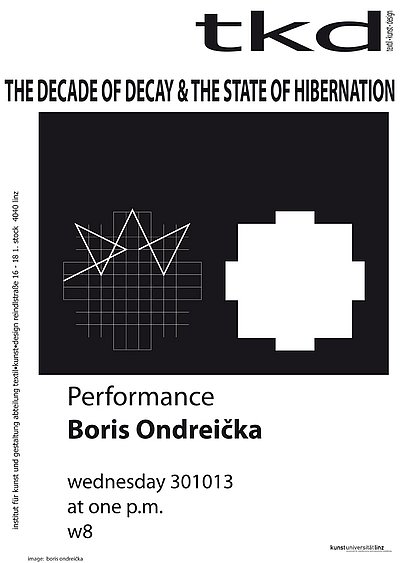THE DECADE OF DECAY & THE STATE OF HIBERNATION
MI 30. Oktober 2013, um 13.00 Uhr Reindlstraße 16-18, 1. OG, Raum W8
Die Abteilung textil·kunst·design lädt zu einer Performance von Boris Ondreička.
„Is this a sign of a culture in decay or a sign of something about to happen? Reminds me a bit of my early teens in the mid-seventies when the best music was always at least 10 years old. In 1976 we were desperate for something - and then punk happened. Any chance art could do the same?“
- Charles Esche, the director of Van Abbemuseum, Eindhoven, NL, curator and author, editor of Afterall, teaches at Central St Martins College, London, UK, and Rijksakademie, Amsterdam, NL, on Facebook, June 9, 2011, 00:01 am, comming back from the preview of The Venice Biennale
Boris Ondreička is a singer, author, curator and artist whose works deal predominantly with language, both in its spoken form as performed poetry, and in writing, with a particular focus on typography. His work never assumes a final form or materializes in objects; rather, it constitutes itself as a permanent process, based on a pool of “materials” which are assembled and recombined in site- and context-specific interventions.
Aside from text—mostly his own writings—his work encompasses a vast and ever-changing collection of images, appropriated from various sources and different historical epochs. It is in the space between text and image that his work temporarily nests. This is the space of the imagination, or in other words, of morphological figuration, in which the differences between form and image, image and meaning, become porous and unstable. These differences can be blurred or enhanced through the strategic use of semantic shifts and displacements, that is, through the conceptual act of poetry. The inconsistencies of meaning and rationality are embraced by music and rhythm. It is this immersive, associative, and even hallucinatory quality unleashed in language and images through their musical activation that is at the core of Ondreička's work. Both language—spoken text or written words—and images—concrete or abstract—here become sensors of sorts for what Ondreička simply calls “frequencies,” which is something we may experience as viewers in the rhythm of our associations and emotional reactions, but which also is a way of “recording” history—a history quite different from linear time, but no less actual, embodied, and sensual. Hence, DNA as the physical “code of life” is a persistent motif in Ondreička’s work—and the spiraling double helix is perhaps an image par excellence for the willful collapse of dialectics, for folding opposites into each other along a certain “frequency.” And it is also an image for scientific laws and determination, as the code or program from which emerges all living forms.
Ondreička’s performance and installation Black Birds and Blackbirds for the Taipei Biennial investigates the “dark” side of all form and meaning—the unknown, the realm of the hallucinatory, irrational, or compulsive—and the pure “imminence” of form, that is, the point where the difference between form and mental process or social relation evaporates, where “reading” and “immersion” become one and the same.
ANSELM FRANKE FOR TAIPEI BIENNALE 2012
Biography Boris Ondreička.pdf
PLAKAT Boris Ondreička Performance.pdf

